Buffalo Sabres: Every retired number in franchise history

In 2022, the Buffalo Sabres added Ryan Miller’s famed #30 to their list of retired numbers. Which players received the honor before him?
The Buffalo Sabres have retired nine numbers in their history as an NHL franchise. And nearly every single one of them made a huge impact on the organization. Since only so many numbers exist, for a player to have their number retired is considered to be a true honor.
So if you are new to the Buffalo Sabres or if you are just looking to familiarize yourself with their history, this is an article that you will want to read. It outlines some of the most historic careers not only in team history, but also in NHL history.
Are you ready to relive some illustrious moments and even catch a fun fact or two? Keep reading, starting with a retired number of a man whose name you may be quite familiar with.
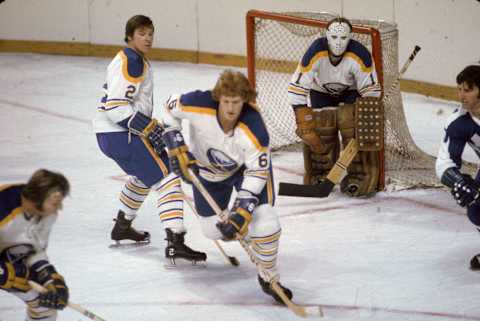
A rundown of every retired number in Buffalo Sabres history: Tim Horton’s #2
Miles Gilbert Horton, as some have known him. And if his name is familiar to you, it is because Horton indeed co-founded the coffee and doughnut fast-food chain Tim Hortons. But Horton was also a legendary NHL player who played for 25 seasons in the league. And no, that is not a typo.
He spent most of those years up in Toronto with the Maple Leafs. But Horton also played for the New York Rangers and the Pittsburgh Penguins before he joined the Buffalo Sabres for the 1972-73 season.
And despite joining the Sabres via an intra-league draft toward the tail-end of his career, he played in 124 games for the franchise, helping them reach their first Stanley Cup Playoff appearance in franchise history. His performance led general manager Punch Imlach, with whom he had connections with during his time with the Maple Leafs, to sign him to an extension.
Horton, however, would only play in 55 of the team’s scheduled 78 games, as he was killed in a single-car crash in the early morning of February 21st, 1974. He was 44 years old.
While Horton had a short career with the Sabres, it was nonetheless a memorable one, considering his presence did help the franchise reach its first of many playoff berths. But three of Horton’s teammates are arguably the most unforgettable players in franchise history.
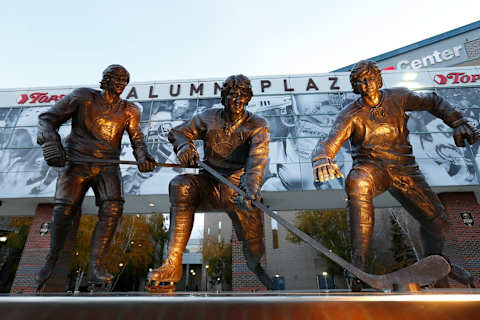
The French Connection
Gilbert Perreault’s #11
Perreault was nearly the first overall pick of the expansion Vancouver Canucks had Punch Imlach not contested the numbers on the roulette wheel that would determine the first overall pick. After NHL President Clarence Campbell saw the error that Imlach pointed out, he rightfully awarded the Buffalo Sabres the first overall selection, which they used to select Perreault.
Perreault was the first of three legendary Sabres that would become known as the French Connection. The group of forwards would dominate the NHL throughout the 1970s, and Perreault’s numbers show that he is no exception.
Throughout his career in Buffalo, Perreault logged 1,326 points in 1,191 games, 512 goals, and 814 assists. He also enjoyed a career shooting percentage of 16.6. Perreault won the Calder Trophy in his rookie season, the Byng Trophy in 1973, two Second Team NHL All-Star honors, and he competed in six All-Star games.
Rick Martin’s #7
Martin played 681 of his 685 career games with the Sabres and just four with the Los Angeles Kings. He arrived in Buffalo the season after Perreault, and they immediately became a dynamic duo. Martin finished second for the Calder in his rookie season, but he would go on to earn First and Second Team All-Star honors on four different occasions. Martin also played in seven NHL All-Star games.
For his career with the Buffalo Sabres, Martin tallied 681 games, 695 points, 382 goals, and 313 assists. He would have a career shooting percentage of 15.2.
Rene Robert’s #14
Robert joined the Sabres in the second half of the 1971-72 NHL Season, scoring nine points in 12 games. And in 1972-73, he became the third member of the French Connection, appearing in 524 games with the Sabres and scoring 552 points, 222 goals, and 330 assists in that span.
Robert played in two All-Star games, and he even earned Second-Team NHL All-Star honors in the 1974-75 season. Following his time in Buffalo, Robert spent a stint with the Colorado Rockies before he returned to the Toronto Maple Leafs, the team he started his career with.
Retirement Ceremonies
Perreault’s number was the first to be retired in team history. He would also be the only Buffalo Sabre to wear number 11. When the Sabres decided to retire Martin’s and Robert’s numbers 7 and 14, they briefly lowered Perreault’s number from the rafters before re-raising it between the #7 and #14, symbolizing the Sabres as retiring the French Connection line simultaneously.
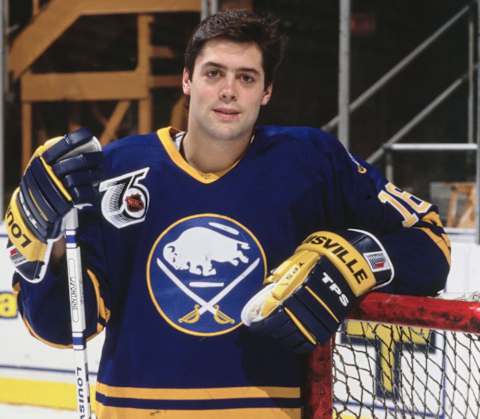
Pat LaFontaine’s #16
Like many players on today’s list Pat LaFontaine began his career with a franchise other than the Buffalo Sabres. He spent six of his 15 NHL seasons in Buffalo, and arguably the best year of his career came during his time with the Sabres.
In the 1992-93 season, his second with Buffalo, LaFontaine scored an astounding 148 points, 53 goals, and 95 assists, earning Second Team NHL All-Star honors in the process. He also received consideration for the Byng, Hart, and Selke Trophies.
Although LaFontaine’s career with the Sabres took a downturn in the following two seasons, he still won the Bill Masterton Trophy in 1995. The award showed LaFontaine’s commitment to hockey, and his incredible comeback season in 1995-96 further proved he was worthy of such an honor.
Overall, LaFontaine played in 268 games with the Sabres, scoring 385 points, 158 goals, and 227 assists. He is also a member of the Hockey Hall of Fame. After LaFontaine left the Sabres following the 1996-97 season, he appeared in 67 contests with the New York Rangers before he called it quits for good.
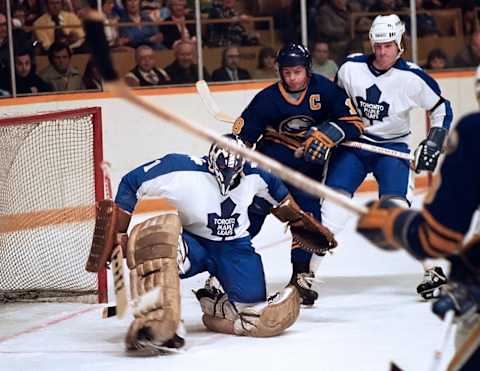
Danny Gare’s #18
A second round, 29th overall selection in the 1974 NHL Draft, Danny Gare burst onto the scene early when he placed third for the Calder Trophy. During his time in Buffalo, Gare won Second Team All-Star honors for the 1979-80 season. It was the best year of his career, one in which he tallied 89 points and a league-high 56 goals.
His accolades in 1979-80 surpassed that of his 1975-76 campaign, where he found twine 50 times and scored 73 total points. 1980-81 were nearly as good, with 46 goals and 85 points in 73 games. And although he did not make the NHL All-Star Team that year, he did find himself playing in his second of two All-Star Games.
To make matters more impressive for Gare, he enjoyed immense success early in his career when the famed French Connection dominated both the Buffalo Sabres offensive statistics and the NHL itself. After he left Buffalo during the 1981-82 NHL Season, Gare spent time with both the Detroit Red Wings and the Edmonton Oilers. He retired following his 1986-87 campaign.
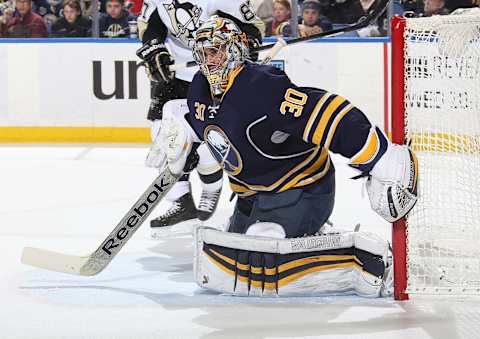
Ryan Miller’s #30
In 2022, the Buffalo Sabres announced they would retire the legendary Ryan Miller’s #30 in January 2023. And had he spent his prime with most other NHL franchises, Miller would probably be regarded as the best in that organization’s history. But, he played for the Sabres, and therefore, will probably always be seen as #2 behind Dominik Hasek.
But who cares? Miller is still regarded as an NHL legend and one of the best to throw on the skates. And as the 138th overall pick in the 1999 NHL Draft, Miller wasn’t supposed to enjoy such an illustrious career.
Fate had other ideas, and Miller went on to snag a spot as a First Team NHL All-Star for the 2009-10 season. He also won the Vezina Trophy that year, all while recording a 0.929 save percentage, a 2.22 GAA, and a record of 48-18-8.
Overall, Miller spent 11 seasons with the Sabres, compiling a record of 284-186-57, a 0.916 save percentage, and a GAA of 2.60. He then spent 19 games with the St. Louis Blues and three seasons with Vancouver Canucks, before he rounded out his career with the Anaheim Ducks, for whom he played until 2020-21.
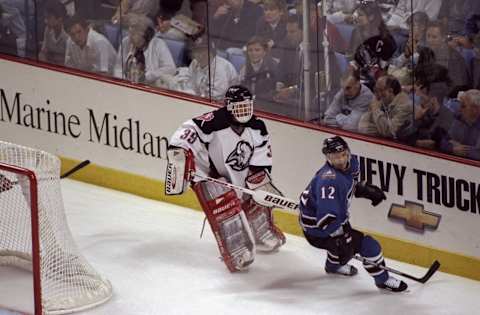
Dominik Hasek’s #39
Depending on who you are talking to, some in the Buffalo Sabres faithful will call Dominik Hasek not just the best goaltender, but even the best player in the organization’s history. Hasek, the 199th overall pick of the 1983 NHL Draft, did not see action at North America’s top level until 1990-91 for the Chicago Blackhawks.
Despite receiving All-Rookie honors and compiling a 13-4-1 record, the Blackhawks dumped him off to the Sabres, and the rest is, well, history. Hasek went on to receive First Team NHL All-Star honors six times. He also appeared in five All-Star Games as a member of the Sabres.
Hasek also won the Vezina Trophy six times, the Jennings Trophy three times, the Hart Trophy twice, and the Pearson Trophy twice. He was also in the net during the team’s Stanley Cup Final appearance in 1999.
Hasek’s best season came in 1997-98, when he earned a First Team spot on the NHL All-Star Team. He also won the Vezina, Hart, and Pearson Trophies. Hasek logged a 0.932 save percentage, a 2.09 GAA, and a record of 33-23-13. He followed up that success in 1998-99 with a 0.937 save percentage and a 1.87 GAA.

Wayne Gretzky’s #99 (League-Wide)
While Wayne Gretzky never played for the Buffalo Sabres, every NHL franchise has retired his number. Therefore, I have decided to include him on this list. Besides, if you are new to hockey, Gretzky is a player you should probably know about.
Simply put, Gretzky was a 15-time All-Star who won four Stanley Cups during his career. He won the Hart Trophy nine times, the Byng Trophy five times, the Ross Trophy 10 times, the Pearson Award five times, and the Smyth Trophy twice. And as you may have guessed, Gretzky forged his way into the Hockey Hall of Fame.
He played for 20 seasons in the NHL, appearing in 1,487 contests. He ended up scoring 2,857 times, good for 1.92 points per game. Of those 2,857 points, 894 went for goals and the remaining 1,963, assists.
Must Read. The top five games from the 2021-22 season. light
Gretzky is regarded by many as the best NHL player of all-time, and is the NHL’s equivalent of Tom Brady, Babe Ruth, and Michael Jordan. It is easy to see why the NHL retired their most legendary player’s number.
(Statistics provided by Hockey-Reference)